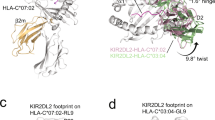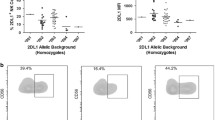Abstract
In the human killer cell immunoglobulin-like receptors, KIR2DL2, and KIR2DL3, a triad of amino acids in the D1 domain interact to stabilize protein structure. Substitution of any one of these residues caused significant loss of cell surface expression. Although KIR2DS4 and KIR2DS5, two homologous receptors, differ for this triad, flow cytometry analysis of NK and T cell lines transfected with stimulatory KIR genes KIR2DS4 (allele *001) and KIR2DS5 (allele *002) demonstrated cell surface expression. For KIR2DS5, restoration of the triad sequence increased surface expression. Further studies of the receptor encoded by KIR2DS5*002 showed both mature and immature protein isoforms upon gel electrophoresis coupled with surface biotinylation or deglycosylation. In contrast, the KIR2DS5*001 allelic product was not expressed on the cell surface of either NK or T cells and exhibited only a single immature isoform upon gel electrophoresis. Site-directed mutagenesis demonstrated that absence of the KIR2DS5*001-encoded protein at the cell surface was imparted primarily by two amino acid polymorphisms in the D2 domain. Analysis using molecular dynamics simulations suggested that the substitution of a proline for a serine at residue 111 or the substitution of a serine for a phenylalanine at residue 164 caused destabilization of the domain structure and intracellular retention. A third polymorphism at residue 174 impacted the level of KIR2DS5 surface expression. This is the first description at a stimulatory KIR locus of the impact of specific amino acid variations on receptor maturation and the level of surface expression.





Similar content being viewed by others
Abbreviations
- KIR:
-
killer cell Ig-like receptor
- 2DL:
-
two extracellular domains, long cytoplasmic tail
- 3DL:
-
three extracellular domains, long cytoplasmic tail
- 2DS:
-
two extracellular domains, short cytoplasmic tail
- MD:
-
molecular dynamics
References
Alter G, Martin MP, Teigen N, Carr WH, Suscovich TJ, Schneidewind A et al (2007) Differential natural killer cell-mediated inhibition of HIV-1 replication based on distinct KIR/HLA subtypes. J Exp Med 204:3027–3036 doi:10.1084/jem.20070695
Anjos S, Nguyen A, Ounissi-Benkalha H, Tessier MC, Polychronakos C (2002) A common autoimmunity predisposing signal peptide variant of the cytotoxic T-lymphocyte antigen 4 results in inefficient glycosylation of the susceptibility allele. J Biol Chem 277:46478–46486 doi:10.1074/jbc.M206894200
Bashirova AA, Martin MP, McVicar DW, Carrington M (2006) The killer immunoglobulin-like receptor gene cluster: tuning the genome for defense. Annu Rev Genomics Hum Genet 7:277–300 doi:10.1146/annurev.genom.7.080505.115726
Berendsen HJC, Postma JPM, Vangunsteren WF, Dinola A, Haak JR (1984) Molecular-dynamics with coupling to an external bath. J Chem Phys 81:3684–3690 doi:10.1063/1.448118
Boyington JC, Motyka SA, Schuck P, Brooks AG, Sun PD (2000) Crystal structure of an NK cell immunoglobulin-like receptor in complex with its class I MHC ligand. Nature 405:537–543 doi:10.1038/35014520
Campbell KS, Cella M, Carretero M, Lopez-Botet M, Colonna M (1998) Signaling through human killer cell activating receptors triggers tyrosine phosphorylation of an associated protein complex. Eur J Immunol 28:599–609 doi:10.1002/(SICI)1521-4141(199802)28:02<599::AID-IMMU599>3.0.CO;2-F
Colonna M, Borsellino G, Falco M, Ferrara GB, Strominger JL (1993) HLA-C is the inhibitory ligand that determines dominant resistance to lysis by NK1- and NK2-specific natural killer cells. Proc Natl Acad Sci USA 90:12000–12004 doi:10.1073/pnas.90.24.12000
Darden T, York D, Pedersen L (1993) Particle mesh Ewald—An N.Log(N) method for Ewald sums in large systems. J Chem Phys 98:10089–10092 doi:10.1063/1.464397
Dohring C, Samaridis J, Colonna M (1996) Alternatively spliced forms of human killer inhibitory receptors. Immunogenetics 44:227–230 doi:10.1007/BF02602590
Dunning AM, Ellis PD, McBride S, Kirschenlohr HL, Healey CS, Kemp PR et al (2003) A transforming growth factorbeta1 signal peptide variant increases secretion in vitro and is associated with increased incidence of invasive breast cancer. Cancer Res 63:2610–2615
Fan QR, Long EO, Wiley DC (2001) Crystal structure of the human natural killer cell inhibitory receptor KIR2DLI-HLA-Cw4 complex. Nat Immunol 2:452–460
Fiser A, Do RKG, Sali A (2000) Modeling of loops in protein structures. Protein Sci 9:1753–1773
Goodridge JP, Lathbury LJ, Steiner NK, Shulse CN, Pullikotil P, Seidah NG et al (2007) Three common alleles of KIR2DL4 (CD158d) encode constitutively expressed, inducible and secreted receptors in NK cells. Eur J Immunol 37:199–211 doi:10.1002/eji.200636316
Hanson RN, Lee CY, Friel CJ, Dilis R, Hughes A, DeSombre ER (2003) Synthesis and evaluation of 17alpha-20E-21-(4-substituted phenyl)-19-norpregna-1,3,5(10),20-tetraene-3,17beta-diols as probes for the estrogen receptor alpha hormone binding domain. J Med Chem 46:2865–2876 doi:10.1021/jm0205806
Hou L, Steiner NK, Chen M, Belle I, Kubit AL, Ng J et al (2008) Limited allelic diversity of stimulatory two domain killer immunoglobulin-like receptors. Hum Immunol 69:174–178
Hsu KC, Liu XR, Selvakumar A, Mickelson E, O'Reilly RJ, Dupont B (2002) Killer Ig-like receptor haplotype analysis by gene content: evidence for genomic diversity with a minimum of six basic framework haplotypes, each with multiple subsets. J Immunol 169:5118–5129
Katz G, Markel G, Mizrahi S, Arnon TI, Mandelboim O (2001) Recognition of HLA-Cw4 but not HLA-Cw6 by the NK cell receptor killer cell Ig-like receptor two-domain short tail number 4. J Immunol 166:7260–7267
Katz G, Gazit R, Arnon TI, Gonen-Gross T, Tarcic G, Markel G et al (2004) MHC class I-independent recognition of NK-activating receptor KIR2DS4. J Immunol 173:1819–1825
Khakoo SI, Carrington M (2006) KIR and disease: a model system or system of models? Immunol Rev 214:186–201 doi:10.1111/j.1600-065X.2006.00459.x
Khakoo SI, Thio CL, Martin MP, Brooks CR, Gao X, Astemborski J et al (2004) HLA and NK cell inhibitory receptor genes in resolving hepatitis C virus infection. Science 305:872–874 doi:10.1126/science.1097670
Lanier LL (2005) NK cell recognition. Annu Rev Immunol 23:225–274 doi:10.1146/annurev.immunol.23.021704.115526
Laskowski RA, Macarthur MW, Moss DS, Thornton JM (1993) Procheck—a program to check the stereochemical quality of protein structures. J Appl Cryst 26:283–291 doi:10.1107/S0021889892009944
Martin MP, Nelson G, Lee JH, Pellett F, Gao X, Wade J et al (2002) Cutting edge: susceptibility to psoriatic arthritis: influence of activating killer Ig-like receptor genes in the absence of specific HLA-C alleles. J Immunol 169:2818–2822
Maxwell LD, Wallace A, Middleton D, Curran MD (2002) A common KIR2DS4 deletion variant in the human that predicts a soluble KIR molecule analogous to the KIR1D molecule observed in the rhesus monkey. Tissue Antigens 60:254–258 doi:10.1034/j.1399-0039.2002.600307.x
Middleton D, Gonzalez A, Gilmore PM (2007a) Studies on the expression of the deleted KIR2DS4*003 gene product and distribution of KIR2DS4 deleted and nondeleted versions in different populations. Hum Immunol 68:128–134 doi:10.1016/j.humimm.2006.12.007
Middleton D, Meenagh A, Gourraud PA (2007b) KIR haplotype content at the allele level in 77 Northern Irish families. Immunogenetics 59:145–158 doi:10.1007/s00251-006-0181-7
Moretta A, Bottino C, Vitale M, Pende D, Cantoni C, Mingari MC et al (2001) Activating receptors and coreceptors involved in human natural killer cell-mediated cytolysis. Annu Rev Immunol 19:197–223 doi:10.1146/annurev.immunol.19.1.197
Pando MJ, Gardiner CM, Gleimer M, McQueen KL, Parham P (2003) The protein made from a common allele of KIR3DL1 (3DL1*004) is poorly expressed at cell surfaces due to substitution at positions 86 in Ig domain 0 and 182 in Ig domain 1. J Immunol 171:6640–6649
Parham P (2003) Immunogenetics of killer-cell immunoglobulin-like receptors. Tissue Antigens 62:194–200 doi:10.1034/j.1399-0039.2003.00126.x
Parham P (2005a) Immunogenetics of killer cell immunoglobulin-like receptors. Mol Immunol 42:459–462 doi:10.1016/j.molimm.2004.07.027
Parham P (2005b) MHC class I molecules and KIRs in human history, health and survival. Nat Rev Immunol 5:201–214 doi:10.1038/nri1570
Robinson J, Waller MJ, Stoehr P, Marsh SG (2005) IPD—the Immuno Polymorphism Database. Nucleic Acids Res 33:D523–D526 doi:10.1093/nar/gki032
Saulquin X, Gastinel LN, Vivier E (2003) Crystal structure of the human natural killer cell activating receptor KIR2DS2 (CD158j). J Exp Med 197:933–938 doi:10.1084/jem.20021624
Stewart CA, Laugier-Anfossi F, Vely F, Saulquin X, Riedmuller J, Tisserant A et al (2005) Recognition of peptide-MHC class I complexes by activating killer immunoglobulin-like receptors. Proc Natl Acad Sci USA 102:13224–13229 doi:10.1073/pnas.0503594102
Thompson JD, Higgins DG, Gibson TJ (1994) Clustal-W—improving the sensitivity of progressive multiple sequence alignment through sequence weighting, position-specific gap penalties and weight matrix choice. Nucleic Acids Res 22:4673–4680 doi:10.1093/nar/22.22.4673
VandenBussche CJ, Dakshanamurthy S, Posch PE, Hurley CK (2006) A single polymorphism disrupts the killer Ig-like receptor 2DL2/2DL3 D1 domain. J Immunol 177:5347–5357
Vilches C, Gardiner CM, Parham P (2000a) Gene structure and promoter variation of expressed and nonexpressed variants of the KIR2DL5 gene. J Immunol 165:6416–6421
Vilches C, Pando MJ, Rajalingam R, Gardiner CM, Parham P (2000b) Discovery of two novel variants of KIR2DS5 reveals this gene to be a common component of human KIR ‘B’ haplotypes. Tissue Antigens 56:453–456 doi:10.1034/j.1399-0039.2000.560510.x
Winter CC, Gumperz JE, Parham P, Long EO, Wagtmann N (1998) Direct binding and functional transfer of NK cell inhibitory receptors reveal novel patterns of HLA-C allotype recognition. J Immunol 161:571–577
Yawata M, Yawata N, Draghi M, Little AM, Partheniou F, Parham P (2006) Roles for HLA and KIR polymorphisms in natural killer cell repertoire selection and modulation of effector function. J Exp Med 203:633–645 doi:10.1084/jem.20051884
Acknowledgements
Funding from the Office of Naval Research N00014-05-1-0784 and N00014-06-1-0726 (C.K.H.) supported this research. The views expressed in this article are those of the authors and do not reflect the official policy of the Department of Navy, the Department of Defense, or the United States government. These studies were conducted using the Tissue Culture and Flow Cytometry and Cell Sorting Shared Resources of Lombardi Comprehensive Cancer Center supported by National Cancer Institute Cancer Center Support Grant CA51008. Computing time and staff support was in part provided by the Advanced Biomedical Computing Center at the National Cancer Institute (Frederick, MD). We thank Karen Creswell and Michelle Lombard for providing excellent technical assistance and Tiernan Mulrooney, William Frazier, and Phillip Posch for helpful discussions.
Author information
Authors and Affiliations
Corresponding author
Rights and permissions
About this article
Cite this article
Steiner, N.K., Dakshanamurthy, S., VandenBussche, C.J. et al. Extracellular domain alterations impact surface expression of stimulatory natural killer cell receptor KIR2DS5. Immunogenetics 60, 655–667 (2008). https://doi.org/10.1007/s00251-008-0322-2
Received:
Accepted:
Published:
Issue Date:
DOI: https://doi.org/10.1007/s00251-008-0322-2




